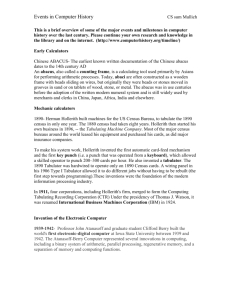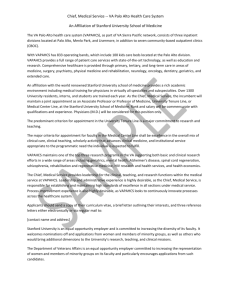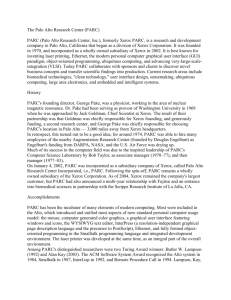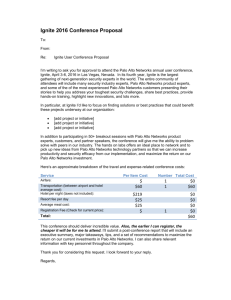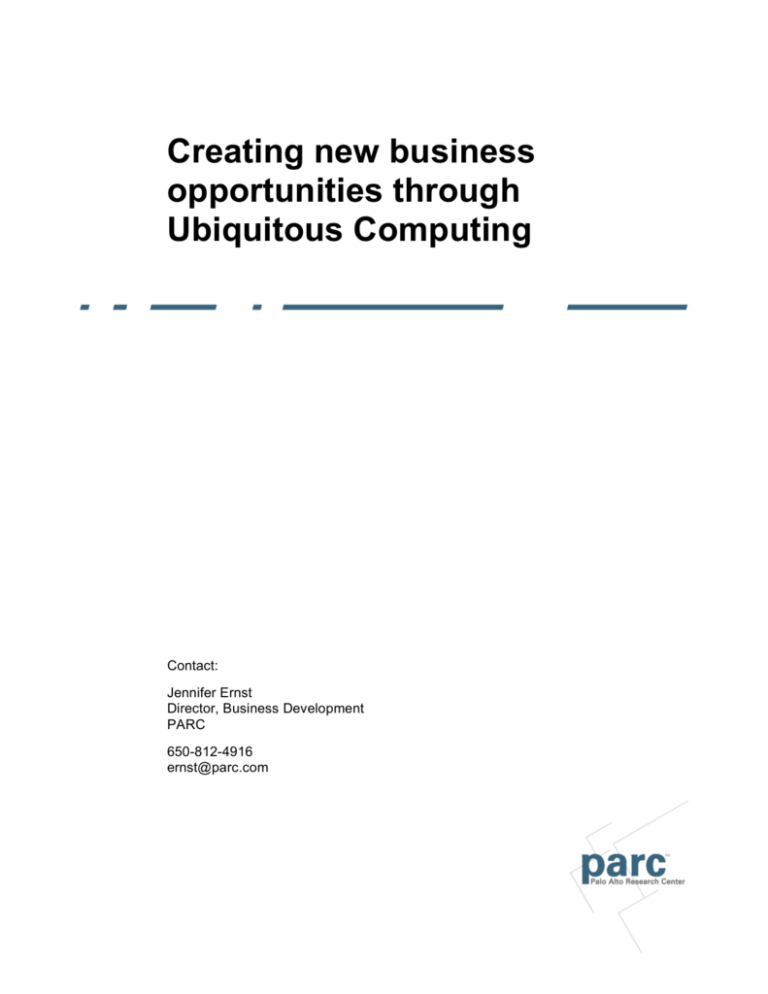
Creating new business
opportunities through
Ubiquitous Computing
Contact:
Jennifer Ernst
Director, Business Development
PARC
650-812-4916
ernst@parc.com
Copyright © 2008 Palo Alto Research Center Incorporated.
All Rights Reserved.
PARC and the PARC Logo are registered service marks
and Objé™ is a trademark of Palo Alto Research Center
Incorporated. All other trademarks belong to their
respective owners.
Palo Alto Research Center
3333 Coyote Hill Road
Palo Alto, CA 94304 USA
www.parc.com
info@parc.com
+1 (650) 812-4916
Palo Alto Research Center
Page 2 of 13
We have been liberated from the desktop. As mobile and embedded computing
systems increasingly pervade environments, more and more information and content
is available throughout our daily surroundings. Sometimes we proactively seek that
information – via our laptops or MP3 players or smart phones. Other times, the
information is offered automatically, through GPS systems, for example, or sensortriggered signage.
These pervasive appliances and applications offer new sets of technical and business
challenges – along with ubiquitous and fascinating opportunities for innovation,
especially in the areas of managing information overload, making computing
environments transparent to users, and enabling mobile and ambient devices to
serve as intelligent interfaces to our physical surroundings.
Information environments shaped by user intent and context,
where content is not “king”
As digital devices and systems proliferate, it is vital to address human needs first and
foremost—rather than consider the technology first and then look for a problem that
the technology might solve.
These days, people increasingly try to multi-task by juggling the simultaneous use of
communications and PDA devices, entertainment gear, home appliances, and even
transportation systems. Yet these entities generally do not interact in meaningful
ways with each other for the purpose of responding to the user’s tacit needs. The
performance of high-tech gear is a specific reaction to the user’s precise input
commands, delivering or referencing the content accessible by only that particular
device.
However, when we consider the opportunities to equip these systems with sensing
capabilities, effortless user interaction, and interconnectivity capabilities, we can
envision ways in which they can automatically perform for us within the context of the
activities in which we are engaged and the behavior that characterizes our unique
personal needs.
By observing the physical environment in which the system is in use, and by
recording and analyzing user behavior, intent-aware and context-aware systems can
detect people’s intentions without requiring complex, real time, manual interactions. A
system that can infer a user’s intention can deliver information in anticipation of the
user’s expressed need for that material—able to proactively deliver services and
information to transform the ways in which we live, play, and work.
As sensors become less expensive and easier to connect to the Internet, they can
give computing technologies “eyes” and “ears” to make sense of the physical world.
Orwellian as that may sound, myriad benefits appear possible: from the simple
convenience of letting devices handle mundane tasks (media playback, shopping) to
the availability of applications that assist mentally and physically challenged people…
Palo Alto Research Center
Page 3 of 13
that enable more efficient consumption of energy resources … that coordinate safety
and rescue efforts… or that provide tighter physical and virtual security.
Intent-aware computing is about developing, evaluating, and improving the user
experiences, systems, technologies, protocols, and algorithms, to make these and
other applications possible and profitable.
Core issues to address
As digital devices increasingly show up in our daily activities, user interaction models
are failing to deliver consistently optimum experiences. Most user interfaces are
designed by engineers, not social scientists, cognitive scientists or interaction
designers. These exquisitely engineered products boast myriad functions (“featureitis”) and extensive access to functions. The trade-off is in the user experience. Multitaskers struggle to operate two or three systems at once, or while accessing data and
simultaneously engaging in another activity. Or consider the handheld device user,
who doesn’t want to concentrate on the product. Feature-itis demands user attention.
Adding insult to injury, the handy devices have limited display size and input
capabilities.
Herein we find myriad opportunities for intelligent, adaptive user interfaces and
systems that “know” what people want and how to deliver it to them in seamless,
effortless ways.
Another issue arises from the emergence of sensing technologies, which are part of
the foundation for intent-aware computing. The marketplace is poised to present
unprecedented demand for data sources and data exchange. Until mobile information
services are truly pervasive, how do we provide the data necessary within a
geographical region to deliver vast stores of meaningful information to users based
on user behavior and environment? This issue requires addressing media device and
system interoperability and data exchange.
When considering the widespread use of sensor networks and devices that track user
behavior, we face the challenge of how to simplify operations and ensure security at
the same time. Privacy and security concerns can prevent widespread adoption of
mobile tools, so they must be addressed in conjunction with the other issues.
Transforming the approach
Previous commercial attempts at adaptive user interfaces have informed the current
marketplace and technological approaches. Today it is relatively easy to identify, for
example, the reasons for the poor business performance of Microsoft’s 1995
“Microsoft Bob,” positioned as a one-size-fits-all, user-friendly interface for Microsoft
Windows. In a retrospective assessment 11 years later, PC World editor in chief
Harry McCracken critiqued, “It seems to be aimed at a six-year-old.” Microsoft Bob
was introduced when the World Wide Web started gaining global acceptance, yet
Bob offered no web-related functionality.
Palo Alto Research Center
Page 4 of 13
Part of the problem inherent in this and other attempts at developing adative
interfaces, both past and current, is that the developers address the problem—and
the marketplace—from a technology perspective (“what is possible to achieve?”). A
more effective method to initiate innovation involves asking the question:
“What do people want to be able to do?”
Then, the responses are best evaluated within the context of the market, the
technology, and the network infrastructure.
And naturally, today, unlike in Microsoft Bob’s day, Internet technologies figure
prominently in efforts to integrate computing systems within intent-aware and contextaware market opportunities-- such as information retrieval, interactive advertising,
and emerging electronic communication and social media techniques.
Sweet spots for commercialization
With a unique, industry-savvy social science perspective and computational science
legacy, PARC is exploring ways for users to more easily understand, configure, and
control complex environments composed of devices and services designed without
the intention of interoperating. This requires bridging between physical and digital
domains.
Our ultimate goal is to enable seamless interaction with pervasive systems that
deliver seamless performance. Beneficial things would just “happen” for people,
thanks to the sensing, computing technologies on us, near us, or surrounding us.
Toward this end, PARC takes a unique multidisciplinary approach to identifying
game-changing challenges in the industry that we can solve today. We have
identified ways to apply emerging and converging technologies, designing novel
techniques for uses ranging from task management to location-based services. Our
ubiquitous computing work involves four broad, interdependent innovation areas:
(1) Anticipation of human needs: Behavior, Activity, & Intent-Aware Systems
To deliver information based on inferring particular user activity, our research shows
the effectiveness of modeling user behavior by employing and aggregating a range of
electronic data sources such as keyboard use, calendar items, email, and web use,
physical data sources, including location, date, time, sound, motion, vision, previous
behavior, and historical data sources (diary entries describing activities).
Intent-aware computing adds value only when used to infer the user’s ultimate goal.
One implementation of this approach is in a retail setting where signage displays
dynamic animation – driven in part by sensor technology enabling it to respond to a
shopper’s eye gaze to infer and present relevant content.
Palo Alto Research Center
Page 5 of 13
Presently, most advanced sensor devices are deployed for industrial control,
environmental monitoring, and security applications. PARC has developed a system
that enables wireless sensors to interoperate using optimal processing and
messaging formats that conserve the sensor’s limited battery power. This approach
forms the foundation for intent-aware computing, a new area that integrates research
from several disciplines: ubiquitous computing, artificial intelligence, human-computer
interaction, psychology, anthropology, and specialized subfields of these areas.
Intent-aware technologies have broad implications for the future of how businesses
relate to consumers. How do people behave and use a company’s products? What
are the best ways for making recommendations or prompting a person to take action?
Having that class of information has great power for any organization—and acting on
it could fundamentally alter the customer-vendor relationship, as well as an
organization’s operations.
Once sensors automatically infer a consumer’s activities, and transmit this information
to the consumer’s social network, vendors and providers (and their competitors) must
be ready and open to change and adapt to new markets for information, new
capabilities and applications, and previously unimagined enhancements to existing
technologies.
Companies that hold intellectual property in this area will be rewarded significantly.
(2) Reduction of barriers: Data & Device Infrastructure
In today’s marketplace, open standards define the media formats and encodings
used across manufacturers, and are necessary to provide consumers with the
freedom to choose among compatible devices. However, standards such as
Bluetooth, ZigBee, Universal Plug and Play (UPnP), and the Digital Living Network
Alliance, all require time-consuming negotiation. They also fail to accommodate
unforeseen technical advances.
PARC is able to address the need for universal interconnectivity by building upon the
Objé™ Interoperability Framework: a radical new way to design devices and services
to easily interoperate and provide coherent user-interaction experiences. We built our
wireless sensor network, for example, on Objé, which combines mobile code and
“meta-interfaces” in an open solution for development.
The Objé framework also provides mechanisms to deliver the right interfaces to the
user at the right time to enable control of many types of devices. For example, Objé
can dynamically send content from a media source (TV, cable box, media server,
etc.) to a player (display, speakers, printer). The framework provides a flexible
security mechanism for safe interconnection of trusted and untrusted devices and
services, all under the user’s direct control.
By enabling fast time-to-market for new media formats and encodings, Objé offers a
way to transform the market for digital devices. Consumers can remain confident that
Palo Alto Research Center
Page 6 of 13
their current and future electronic products will work together. Manufacturers can
more freely introduce innovative devices and networking options. Reliable
interoperability allows consumers to make unexpected connections between devices,
creating a network effect as more and more interoperating devices create new value
for the user.
(3) Greater individual control of environments: Lightweight, Fluid & Dynamic
User Interaction Techniques
The quest for easy user interaction is being addressed by focusing on end-user
control of information environments. Our fundamental goal is to seamlessly interact
with many public and shared devices, delivering Internet and location-based data and
services, with ease and immediacy. Users must be able to quickly and effortlessly
make the connections needed to receive the desired services and information.
Emphasizing mobile and wearable interaction techniques, PARC invents systems and
techniques to improve users’ ability to seamlessly interact with digital information
while engaging in other activities. We are interested in diverse approaches and
devices to solve these problems; recently we have investigated several techniques.
In one approach, PARC developed the OSCAR user interface, and designed and built
a handheld- and tablet-based prototype (simultaneously demonstrating the ease of
composing and configuring devices using the Objé platform). Analogous to a
universal remote controller for media devices, OSCAR is a universal connector,
allowing people to easily define connections between devices and services in our
increasingly wirelessly networked homes. We have conducted iterative user studies
to improve and refine OSCAR, and to ensure that non-technical users can use
OSCAR to compose and control various devices for managing a wide range of tasks.
Two other, recent PARC innovations in user interaction design are the Paradiddle
text-entry technique and the Wrist Top UI form factor for wearable computing.
The “Paradiddle” technique lets users enter text on virtually any surface—such as
touch-sensitive surfaces embedded in devices, clothing, furniture, vehicles, or
buildings. It is device-independent, extremely flexible and adaptable; you make
sequential finger taps to enter text. This approach builds upon our understanding that
certain wearable technologies will make it possible to create quick text entries via any
sufficiently solid surface.
PARC built a prototype of the wrist-mounted “Wrist Top” display that provides easy
access to information; it is outfitted with sensors that allow users to interact with
information and applications by moving and rotating their arms.
(4) Ubiquitous personal SECURITY and PRIVACY
Businesses interested in deploying context- or intent-aware technologies usually
understand the potential for some customers to perceive activity detection as
Palo Alto Research Center
Page 7 of 13
invasive. Not everyone expresses enthusiasm for “smart” devices that learn and
adapt to one’s personal preferences. Consumers will demand control over the
process of notification regarding their personal lives.
PARC’s computer scientists, cryptographers, and sociologists are determining ways
to inform users about how the information about them is being applied, and
techniques for users to directly and transparently manage their exposure. Our
approach, for example, equips systems to automatically detect privacy risks to
prevent identity fraud. Our researchers emphasize in-network data processing,
simplified and scaleable programming, and practical yet robust approaches to
security and privacy.
Palo Alto Research Center
Page 8 of 13
“Intent Awareness” vs. “Behavior (Activity) Awareness” vs. “Context Awareness”
There are four tiers of “smart” ubiquitous systems. At each level, different classes of
applications are possible to automatically serve the user’s goals and desires.
Context-aware systems detect the location, time, nearby people and other aspects of a
person’s physical environment. Context-aware systems enable applications that are
triggered by context, regardless of individual behavior patterns. Examples:
-
Motion-sensing light switch
Storage of data indexed by context
Location-based services
Selecting nearest printer
Sharing situation awareness with others
Behavior-aware systems model the patterns of a person’s actions in different contexts.
“Behavior” can be conscious or unconscious, overt or covert, and voluntary or involuntary
such as typing, walking, standing, holding, turning, clicking, etc. Behavior-aware systems
enable applications that infer, and potentially respond to, present behavior without
necessarily understanding the user’s conscious activity or intent. Examples:
-
Consumer observation
Security monitoring
“Contextual” reminders
Contextual learning
Activity-aware systems model the person’s activity from observations of context and
behavior patterns. In contrast to “behavior” where a person’s actions are not necessarily
consciously made, “Activity” is a conscious, voluntary pursuit, such as “shopping for
clothes,” “writing a report,” “searching for an answer,” “explaining a solution,” etc.
-
Interruptibility modeling
Pro-active information delivery
Mobile information recommendation
Health monitoring
Elder care
Activity-targeted Advertising
Intent-aware systems have insight into the user’s current state of mind, possibly inferred
from context, behavior and activity models. Intent-aware systems sufficiently predict future
behavior to have value in the present. Examples include planning systems (travel routes,
task plans, etc.).
Palo Alto Research Center
Page 9 of 13
Creating opportunities with emerging technologies
How might an individual’s activities establish a context for targeted, responsive,
promotional messages? PARC is exploring responsive media technologies as a
platform for modeling sequential interactions and behaviors between buyers and
sellers. Responsive media use computer-initiated interactions with retail shoppers to
attract, detect, and maintain customer engagement with products or messages.
Content segments play at specific points in the standard cycle of interactions between
buyers and sellers; the system infers and predicts the shopper’s intentions.
To explore opportunities for responsive media in the buying and selling of clothes,
and also to explore potential responsive media design requirements in the “bricks and
mortar” retail setting, PARC recently designed and built a complete prototype
installation, the Responsive Mirror, an interactive, fashion recommendation system.
The Responsive Mirror is an implicitly controlled video technology for clothes fitting
rooms. Watching his reflection in an apparently conventional mirror, a shopper may
directly compare a garment he’s trying on adjacent to an image display of photos of
himself wearing the garments he previously tried on. In both his live reflection and the
photographs of his previous outfits, his physical poses match. The system also allows
live, side-by-side comparison to fashions popular with friends in the shopper’s social
network. PARC’s user study elicited a number of design challenges and tradeoffs that
designers of such technologies must consider regarding privacy, adoption, benefits to
shoppers and merchants and user behaviors in fitting rooms.
When a person interacts with a fitting room mirror, he provides implicit cues about the
information he seeks. When he turns his body, he is observing how the clothes look
from a different angle. Sensors can be used to detect this implicit information-seeking
behavior, and supplemental information can be provided. Shoppers need not be
taught how to use the system – they behave naturally.
Kyoko is a 22-year-old woman shopping for blouses in a small clothing store.
She browses the rack of recent arrivals for tops in her size, takes a selection
into the changing room, and puts them on, one at a time. Each time, she exits
the changing room and stands in front of the mirror, turning to view the blouse
from multiple angles.
Kyoko notices the two, large, flat-screen displays, one on either side of the
mirror (although she doesn’t immediately notice the small video camera
mounted atop the mirror, aimed directly at her). One screen shows Kyoko
wearing each previously worn blouse. As Kyoko turns to view her blouse from
multiple angles, the changing images of her in the previous blouse match her
poses as she moves around to compare the fit and style from each angle of
view: front, left, right, and back.
Palo Alto Research Center
Page 10 of 13
The results of this research contribute to our understanding of the potential impact of
ubiquitous computing technology in the domain of physical shopping.
In another project, inspired by the popularity of online advertising based on the
context of users typing keywords into a search engine, our scientists have noted that
targeting mechanisms for ubiquitous computing environments lack analogous
approaches. Moreover, none of the current, interactive electronic advertising systems
explicitly models a consumer’s abstract activity.
In this study, PARC has applied activity detection to targeted advertising. To research
data collection issues, behavior pattern-capture, product requirements, and potential
market value, we developed the Proactive Experience Sampling Tool. We deployed
mobile phones to monitor subjects engaged in certain activities to enable the
presentation of messages at the time they would make maximum impact. We defined
and evaluated a proposed architecture and its implementation, using two
mechanisms to link activity descriptions with ad content: direct keyword matching
using an online advertising service, and “human computation” matching, which
enhances keyword matching with help from online workers. Early research findings
show that people consider advertisements related to certain types of current activity
to be more relevant and more useful than non-targeted advertisements.
In the near future, activity detection will achieve sufficient accuracy rates to enable
many new applications, including highly targeted advertising. Combined with locationbased service delivery, PARC envisions a rapidly growing market with many avenues
of opportunity.
Tailoring client services to business models & market analysis
Many research institutions are investigating these areas, focusing on component
discovery. PARC’s approach, though, is to apply foundational scientific understanding
to the implementation of new techniques within entire systems, while maintaining
laser-sharp focus on leveraging our clients’ business models and strategic strengths.
For example, Fujitsu, Ltd., has embraced the need to develop and deliver solutions
for the “ubiquitous network society.” Fujitsu turned to PARC to help define a new,
long-range business plan, and to conceptualize and create opportunities for mobile
information and communications technologies.
As part of this open innovation endeavor, several PARC researchers work on site at
Fujitsu’s Tokyo headquarters, collaborating with internal research, development, and
product organizations. The Fujitsu-PARC collaboration centers on three broad
themes:
1) “Near Zero Administration” for networks: Fujitsu uses PARC’s Public Key
Infrastructure technology to improve usability, automate installation and
Palo Alto Research Center
Page 11 of 13
setup, strengthen ID and password functions, and support VPN application
maintenance.
2) “Recombinant Computing” enables Fujitsu to connect different system
devices through peer-to-peer services, allowing both to take advantage of
previously unseen networked resources—and to interoperate fluidly.
3) Large-Scale Sensor Networks (to be deployed in large public places)
optimize interactions among different types of sensors to reduce and optimize
network bandwidth and battery consumption.
PARC innovations are now being implemented within Fujitsu product lines to enhance
Fujitsu’s offerings in home, retail, and health care.
Creating new business for DNP: Location-based, Mobile
Recommender Services
PARC’s activity detection technologies have been integrated within a
mobile recommender system codenamed “Magitti,” in collaboration with
Japan-based Dai Nippon Printing Company, Ltd. DNP is one of the world’s
largest business service and commercial printing companies. A team of
PARC social scientists, computer scientists, cognitive scientists, and
linguistic scientists joined forces with DNP to collaborate in the
identification of a new market and the invention of new media applications
for handheld phones equipped with GPS and touch-screens.
Our work with DNP focused on developing mobile techniques and
systems to find and filter leisure activities based on the device owner’s
personal interest and preferences, geographical location, and relevance of
data about vendors and their offerings, hours, and pricing.
PARC conducted initial analysis and subsequent development and in situ
evaluation of a conceptual prototype in Japan. Feedback from prospective
users has enabled PARC to further develop the Magitti prototype into a
unique technology concept with an exceptionally easy-to-use, one-handed
interface. The compelling platform portends a promising future for
contextual service delivery.
Palo Alto Research Center
Page 12 of 13
The PARC Difference
The user-centric approaches explained here are much investigated in the academic
milieu. At PARC, we have moved well beyond investigation to:
• Identification of technologies with the greatest commercial value;
• Design of infrastructures and prototypes that simplify construction of “aware”
systems;
• Development of techniques to comprehend and use contextually collected data;
• Invention of methods for representing and reasoning about contextual information.
Our approach naturally leverages PARC’s renowned, historical contributions to
computing science and the field of human-computer interfaces and intelligent
systems, honoring the global precedent set by the late, venerated PARC scientist
Mark Weiser. Under Weiser’s leadership, PARC pioneered the vision of ubiquitous
computing, where technology exists all around us in the form of mobile, sensing, and
embedded technologies. Drawing upon this and other landmark contributions to the
field of computational science, PARC’s current work is distinguished by a focus on
user-centric applications. This includes long-term analysis of tradeoffs between
invasiveness vs. utility in the use of sensor technologies.
At PARC, our work centers on people, not technology. Taking a holistic view of the
capabilities of technology and users to create transformative systems that fit
seamlessly into users’ lives, we can increase the adoption rate of such technologies
and enable higher consumer impact, truly transforming the ways in which we all live
and work . . . liberated from the desktop.
For a demo and to explore how PARC can discover ways for your organization
to build new businesses, please contact Jennifer Ernst, Director of Business
Development: phone 650-812-4916 or email ernst@parc.com.
PARC invented the concept of ubiquitous computing in the early 1990s, embracing
many context-aware computing concepts and techniques. Today, experts in the field regard
ubiquitous or “pervasive” computing as the hardware infrastructure to enable context-aware
computing. PARC has developed systems that blend context-aware computing with seamless
interoperability, simplifying the development of distributed, heterogeneous, context- and
intent-aware applications.
Palo Alto Research Center
Page 13 of 13


